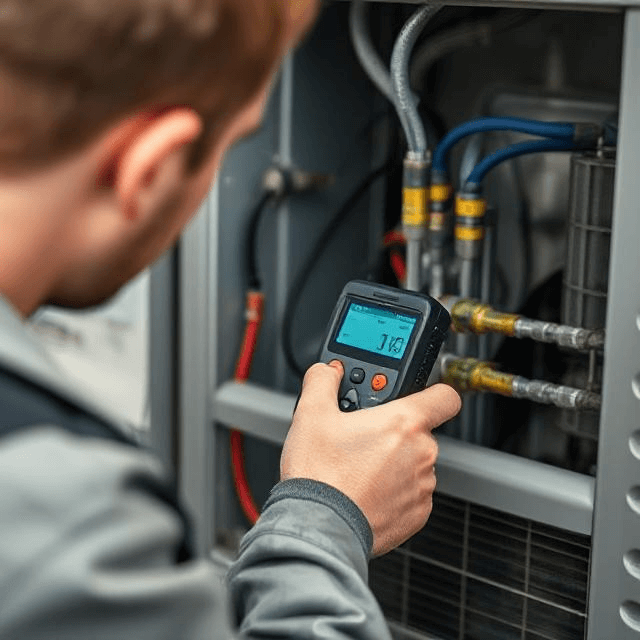Building automation systems (BAS) are revolutionizing HVAC system management by introducing heightened levels of control and efficiency.
This technology ensures that building environments are more comfortable, sustainable, and easily managed.
In this post, Season Control HVAC discusses the transformative impact of BAS, providing a roadmap for those looking to modernize their building systems.
Understanding HVAC and Building Automation Systems
Building Automation Systems (BAS) are centralized networks of software and hardware that control various building services, including HVAC, lighting, fire systems, and security. BAS enhances building functionality and streamlines management tasks.
The integration of BAS with HVAC systems allows for automated control and monitoring, which optimizes energy use, reduces operational costs, and improves system reliability.
This integration enables real-time adjustments based on data from sensors and pre-set parameters, leading to more efficient building management.
Benefits of Integrating BAS with HVAC
- Energy Efficiency: Automated systems ensure HVAC operations run at peak efficiency and reduce energy waste.
- Improved Comfort: Temperature and humidity levels can be adjusted automatically to maintain optimal comfort based on real-time environmental changes and occupancy.
- Enhanced Sustainability: Efficient energy use contributes to a building’s sustainability goals by minimizing its carbon footprint.
- Reduced Operating Costs: Automation reduces the need for manual adjustments and maintenance, lowering operational expenses over time.
Key Features of Building Automation in HVAC Control
Automated Temperature Control
Building automation systems provide precise control over HVAC settings. You can adjust temperatures based on time of day, occupancy patterns, and external weather conditions.
This precision eliminates the need for manual thermostat adjustments, ensuring optimal comfort without energy waste.
Remote Monitoring and Management
BAS has the ability to monitor and manage HVAC operations remotely.
You can access system performance data from any location, enabling quick adjustments and troubleshooting. This enhances the system’s reliability and downtime.
Data Analytics and Reporting
BAS collects and analyzes data from the HVAC operations to identify trends, predict maintenance needs, and optimize performance.
The insights lead to more informed decision-making regarding energy use and system upgrades.
Scalable Integration
Building automation systems are scalable. This means they can be expanded or modified as building requirements change.
The scalability ensures that new technologies or additional building areas can be integrated without major disruptions to existing operations.
Event and Alert Systems
You can program the BAS to generate alerts responding to specific events, such as system failures or deviations from set parameters.
These alerts ensure that issues are promptly addressed, often before they escalate into major problems, thereby minimizing the impact on building operations and comfort.
How Can Building Automation Be Implemented in HVAC Systems?
Assessment of Existing Infrastructure
Evaluate the existing HVAC equipment, control systems, and any automation capabilities. The assessment helps identify any limitations, compatibility issues, or areas that require upgrades to support a BAS.
Selecting the Right BAS Technology
Select the right BAS technology according to the following:
- Specific needs of the building
- The complexity of the HVAC system
- The desired level of automation and control
- Ease of use
- Scalability
- Integration capabilities with other building systems
System Design and Customization
Customize the BAS to meet the unique requirements of the building’s HVAC system. Customization might involve setting specific automation rules, alerts, and control parameters that align with operational goals and efficiency targets.
Installation and Integration
The installation process involves setting up the hardware and software components of the BAS. This step must be carried out by professionals to ensure that the system is installed correctly and is fully functional.
Integration involves connecting the BAS with the HVAC system and other building systems to allow for centralized control and monitoring.
Testing and Commissioning
Thoroughly test the BAS to ensure it operates as intended. Testing includes checking all system components and functionalities under various conditions to verify that they meet the design specifications.
Commissioning involves making necessary adjustments to optimize system performance and ensure that the BAS interacts correctly with the HVAC and other systems.
Training and Handover
Staff training is necessary for the effective management of the BAS. Training should cover how to operate the system, interpret data, and respond to alerts. It’s also important to provide comprehensive documentation and support resources.
Ongoing Maintenance and Updates
Regular maintenance of the BAS ensures long-term performance. Regular maintenance checks, software updates, and system evaluations should be planned to ensure the BAS remains effective and continues to meet the building’s needs.
Key Considerations in Implementing BAS for HVAC Systems
- Initial Costs and Investment: High upfront costs for hardware, software, and installation can be a barrier.
- System Compatibility: Integrating BAS with existing, potentially outdated HVAC systems can present compatibility issues.
- Complexity in Installation: Installation can require skilled technicians and potential disruptions to existing operations.
- Training Requirements: Ensuring staff are properly trained to use the new system effectively involves time and resources.
- Maintenance and Upkeep: Ongoing maintenance is necessary to keep the BAS functioning optimally, which adds to long-term costs.
- Cybersecurity Risks: Increased connectivity with BAS increases the potential for cybersecurity threats, requiring robust security measures.
Embracing the Future of HVAC Management with BAS
Implementing building automation systems (BAS) in HVAC management enhances system efficiency and operational control. By carefully planning and addressing initial setup challenges, organizations can use BAS to improve energy usage, operational cost savings, and overall building comfort.
Embracing this technology is a forward-thinking step towards smarter and more sustainable building management. Get in touch with Season Control HVAC for guidance on enhancing your HVAC system.








